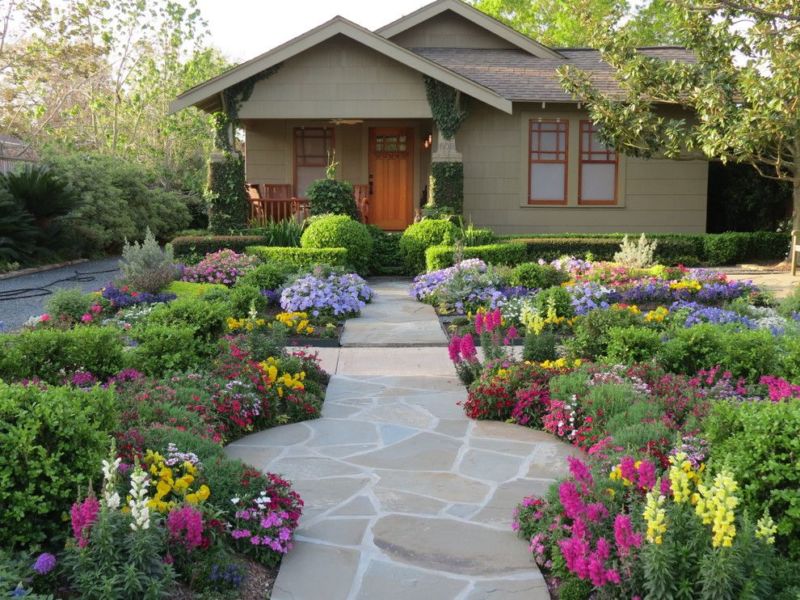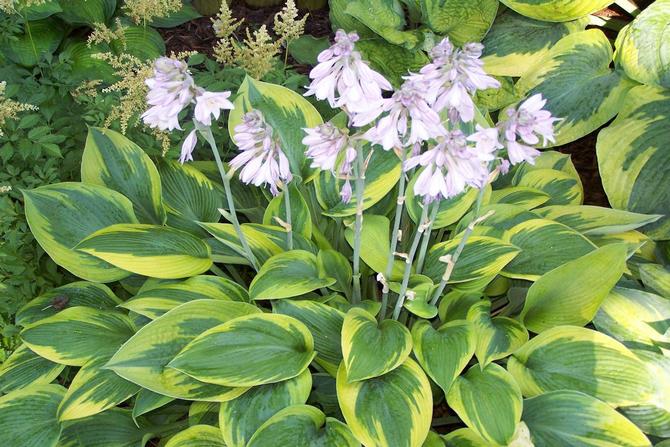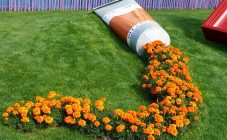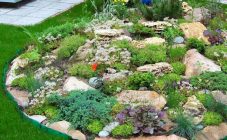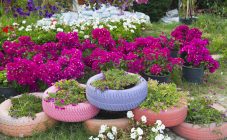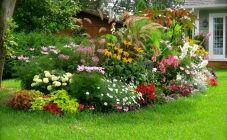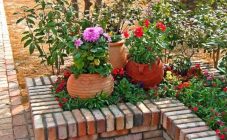Content:
It is difficult to imagine garden plots without flower beds. They ennoble the territory, making even the most modest summer cottage attractive. It is not difficult to find flowers for a flower bed. You can use chic bouquet annuals or meadow plants. Even blooming spicy greens turn the garden into a kind of rabatka.
The basics of landscape design
Semiramis is rightfully considered the ancestor of landscape design, her beautiful garden is a confirmation of this. Now this art is mastered by almost every summer resident. Fortunately, there are many opportunities for decorating the estate - the floral assortment is very large.
To create harmony, you should approach the process knowledgeably:
- flower beds should always be in sight, so it is better to place them in front of the house or near specially designated areas for recreation;
- the basis of design is always composition - the compatibility of various items:
- if we are talking about the site as a whole, then the objects that attract attention are the house and tall trees, all other elements complement them;
- As for the flower beds, a tall garden flower becomes the focal point of the composition.
- all other components are secondary and help the focus in creating the overall picture:
- fill elements create a color background;
- accents serve as a contrast in color or shape (dimensions).
- all items should be combined in size, "balancing" each other;
- creating a flower bed arrangement, they pay attention to other nearby objects, trying to involve them in the zonal plan;
- the correct selection of color shades is important, which not only affect the mood, but also help in visualizing the space.
About the combination of perennial flowers in a flower bed
Flowers are a great addition to the landscape, but they should not be planted randomly, but obeying the laws of design. To make flower beds happy throughout the season, it is recommended to use plants with different flowering periods in the composition.
When a combination of plants is selected, the effect should be created that some flowers seem to “take over” from others. For example, violets and crocuses are the first to smell, and they are replaced by hyacinths and tulips, etc., until late autumn.
The combination of flowers in a flower bed, taking into account different heights, creates the impression that some plants seem to "look out" from behind others. In this case, crops with similar requirements for growing conditions should be used.
List of recommended flowers for summer cottages
| Name | Description | Bush height, cm | Bloom | Note | |||
| Annual plants | |||||||
| Chinese aster | Depending on the variety, the annual can be a spreading or compact bush. The leaves are small, alternate. Combined baskets: in the center there are tubular flowers, along the edges - lingual. Different shades other than orange and white | 25 (short), 40 (medium), 70 (tall) | June August | The plant is demanding on soils, but moisture does not really matter for it. Outwardly, this terry flower in a flower bed looks like a chrysanthemum or peony. | |||
| Marigold | A bare ribbed stem with a thickening below. Loose baskets can be one color or painted in 2 shades (dark orange or brownish red). Leaves are wide, feathery | 30-100 (depending on the variety) | July - September | On the flowerbed, marigolds are found terry, non-double and medium version | |||
| Chrysanthemum | It grows as a bush with straight branching stems. The leaves are shiny and covered with a gray downy. Inflorescences have a variety of shapes, sizes and colors. | Up to 50; 50-90; over 90 | August to late autumn | The plant is demanding for agricultural technology. Sometimes grown in pots to be brought indoors at the end of the season. The main purpose is cutting into bouquets | |||
| Verbena | Herbaceous shrub with densely pubescent 4-sided stems. Leaves can be either oblong or elongated triangular. Flowers 4 cm in diameter are collected in spike-shaped scutes. Available in various colors (except yellow) | 50 | June - October | It is a temperate plant. It belongs to perennials, but is cultivated as an annual. Seedlings are planted in open ground | |||
| Spurge | Scattered pubescent (sometimes glabrous) erect stem is covered with spatulate, on short petioles, leaves 3 cm long. The lower foliage dies off quickly. It has original inflorescences - a lonely pistil surrounded by many staminate flowers. All parts of the plant have the same tonality - yellow-green | 50 | May bloom all summer | When planting on the site, the toxicity of the bush should be taken into account | |||
| Perennial flowers | |||||||
| Garden yarrow | Erect unbranched stem with serrated pinnately dissected leaves. Small flowers - ligulate white, tubular yellow, collected in inflorescences | 20-80 | May - September | Unpretentious to growing conditions. Perennial garden yarrow in a flower bed without thinning forms extensive ovaries | |||
| Periwinkle | The stems, although long, are creeping. The plant takes root with them. Leaves are entire, elliptical. Flowers are five-membered single blue shade, up to 2.5 cm in diameter | 60-90, but in a standing position 20 cm | May June | Groundcover evergreen. In landscape design, periwinkle is best suited for alpine slides and rocky gardens | |||
| Lavender | Hemispherical bush with oblong, linear, sessile leaves. The flowers are bluish-purple, small, collected in whorls (spikelets with a diameter of 1 cm) | 100 | June July | On a flower bed, lavender prefers fertile soil. Due to its frost resistance, it can be grown in northern regions | |||
| Aster | The stem is erect, highly branching. Leaves are small, narrow-lanceolate, basal - scapular. Reed flowers, depending on the variety, have a different shape and color. Tubular, exceptionally yellow. The average diameter of the inflorescence is 3 cm | 50-150 | Depends on the variety | Lingual flowers give the basket a double appearance. In the flowerbed, asters are unpretentious in care. Often grown for cut into bouquets | |||
| Delphinium | Beautiful leafy erect stem with fringed-separate dissected leaves. Inflorescences - pyramidal or cylindrical brushes with spurs, reaching a diameter of 7 cm | 180 | June - September | It stands out for its variety of colors. Under unfavorable growing conditions, the flowers become smaller | |||
| Heuchera | It has a strong, thin, leafless stem. The main foliage is toothed, finger-dissected, growing at the base of the bush. In Heucher, small bells are gathered in panicles at the ends of the shoots. The color depends on the variety | 50-100 | June August | It develops well in all regions, but prefers a sunny hillock. Often grown for forcing and cutting | |||
| Geranium | Straight ribbed stems with edges in the upper part branch. The leaves are appressed-hairy, large at the base and smaller at the tops. Large, five-petal flowers are gathered in pairs at the top of the bush. Have reddish, purple, gray shades (depending on the species) | 30-100 | June - September | Outwardly differs from room geranium. Can grow anywhere without requiring maintenance | |||
| Sage | Compact pyramidal bushes with tetrahedral branches. The leaves are wide, ovate with an elongated tip. The inflorescences are a complex raceme 20 cm in diameter. Can be white, blue or brightly colored | More than 120 | June July | It is best cultivated in seedlings. Prefers a lighted area with loose soil | |||
| Aconite | In the upper part, the stem is covered with a short downy. The leaves are large, with narrow linear segments. Yellow (sometimes blue) flowers can be recognized by the helmet-shaped upper petal. They are collected in brushes from 10 to 40 m | 100 | July August | The plant is unpretentious, but needs a transplant every 3 years | |||
| Barberry | An ornamental shrub with thorny branches. Rhomboid rounded leaves are collected in 4 pieces on shortened shoots. Below the foliage is lighter, with a bluish bloom. Apical racemose inflorescences consist of golden yellow buds | 300 | May June | Produces reddish fruits with a sour taste. It is rarely used for flower beds - only as an additional element of a group composition. More suitable for hedges | |||
| Mallow | Leafy stems, erect. Large toothed, cordate leaves, wrinkled and pubescent. Sessile flowers (15 cm) are collected in a large raceme. There are various colors, except blue | 250 | June - July, some varieties - until September | The stem develops only in the 2nd year. Heat-loving plant, does not bloom in cold summer | |||
| Rudbeckia | Romashka-like upright branchy bush with stiff pubescent stems. It has an edge and oval leaves. Brownish-red or yellow flowers (sometimes purple) 1.5 cm long form baskets 19 cm in diameter | 100-150 | June July | Often used in group plantings, as an annual. Drought-resistant, resistant to frost, not picky about care | |||
| Monarda | Oval pointed leaves grow on rigid tetrahedral erect stems. Red or purple splendor gathered in capitate inflorescences | 80-100 | July August | Requires well-fertilized moist soil. Loyal to other conditions | |||
| Hosta | There is no stem as such - the plant forms a "pillow" of leaves, long, ovoid-oval. Depending on the variety, they can be not only green, but also golden-white, gray or blue. Peduncles without leaves, with one-sided racemose inflorescences of funnel-shaped bells of various shades of blue | Leaves - 20-40; peduncles - up to 105 | July | He prefers sour loams and does not like cold winters, as well as sultry summers. A relatively shade-loving bush that thrives in cramped conditions | |||
| Chamomile | Numerous species, including field and garden options, differing in the size of leaves and flowers. You can recognize the plant by its flower baskets, the middle of which is formed by many yellow tubes. Edges framed by white tongue petals | 60-100 | May - September (depending on the variety) | In flower beds, the most often planted is a daisy, which requires transplanting every 5 years. | |||
From ornamental plants for flower beds that are not included in the table, iris (iris) will help to create beautiful compositions, of which more than 400 varieties of different colors have already been created.
In nature, there are many interesting wild plants that have found their place in summer cottages. For example, some are attracted by their decorativeness of nettle (despite its property of leaving burns on the body).
When deciding what flowers to plant on a flower bed, why not pay attention to ferns - they will become a real decoration of the flower bed. But these plants are capricious and require a lot of attention to themselves. Although the flower beds look very original with a fern.
Even herbs (marjoram, lemon balm, rosemary, rue, etc.) are great additions. Perennial flowers for the garden serve not only as a decor - they scare away harmful insects from the beds and flower beds.
Flower planting schemes in a flower bed
Having figured out which one - and perennial flowers to take for a flower bed, they begin to design a flower garden. It is proposed to consider for beginners an analysis of examples of a flower planting scheme in a flower bed.
When creating a flower bed, perform the following actions:
- outlining the boundaries of the flower garden, remove a layer of soil 15 cm thick;
- having tamped the surface, the mini-pit is covered with broken brick, gravel or pebbles;
- if you plan to break the flower bed into sectors, do it using a marking twine;
- a layer of earth of the order of 40-50 cm is poured in the center of the flower garden;
- moving to the edge, the height of the soil is reduced to 10 cm;
- the perimeter of the flower bed is framed with bumpers made of stone or brick.
A flower bed can be of the same type, but combined plantings look more interesting. This is where you need to learn how to combine colors. There are only 3 main shades in the main spectrum: red, yellow, blue. Combining them gives additional rainbow stripes.
The selection of flowers depends on the size of the flower bed: the smaller the area, the more bright colors are planted. But the flower garden should be based on achromatic colors - white, black and gray. At the same time, dark shades will help to narrow and remove space, light shades will bring closer and expand.
Caring for a flower garden with perennial flowers
For plants to develop better, they need conditions for photosynthesis. Light, carbon dioxide and partly water are provided by nature. The florist only needs to correct these points a little. The main care for perennials is reduced to feeding, combating weeds, pests and diseases.
You cannot do without loosening the soil and mulching. It is also worth worrying about a comfortable wintering of plants. Then the dacha every year will be filled with a heady floral aroma and delight the eye with an abundance of colors.

